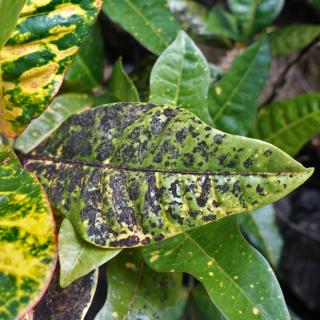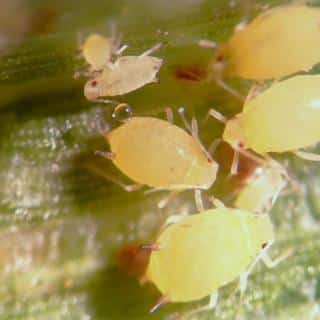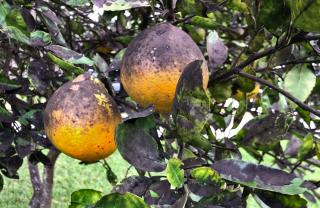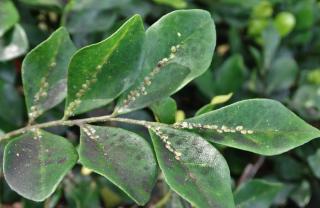

When leaves are covered with a blackish substance, similar to black soot that would have collected overnight, it is a sign of sooty mold.
This fungal disease is well-known to gardeners, and in itself isn’t particularly dangerous. However, it usually appears in tow of parasite infestations that are much more serious, like aphids or scale insects.
The Latin name of the fungus that develop are Capnodium oleaginum, or Fumago salicina. Spores from these strands develop on sweet honeydew produced by the parasites described above.

These parasites produce honeydew, which is a sweet and sticky substance. Air-born sooty mold fungus attaches to this honeydew and develops quickly into a black layer that covers leaves.
Although this doesn’t kill the plant, sooty mold does nonetheless reduce photosynthesis when it covers all leaves with a thick black layer. That is when it suffocates leaves that wither and die.
When sooty mold only spots a few leaves, damage is very limited.

There are a few things to do that can reduce the likeliness that this disease would appear.
The only effective treatment against sooty mold is to first treat the insects that are the cause of it.

Once the plant is treated and these invasive pests have been removed, clean the leaves so that they may again perform their life-giving function.
Cleaning is easy with a damp cloth or rag dipped in lightly soapy water, which you can then rinse with clear water.
Using organic treatments to treat sooty mold protects the ecosystem that surrounds the plant, most especially bees that come pollinate the flowers.

As you deal with the insects themselves, remember to wipe the sooty mold off the leaves, too. Indeed, even if the pests are gone, that dark layer will still block light out, which isn’t good!
The successful way to get rid of sooty mold and black spots on camellias is to defoliate the tree or bush and the next growth cycle will be beautiful and free of problems.
Hi Susan, it’s true that defoliation will get rid of all infected leaves. In the case of black spot, it’ll also reduce the risk of having new spots form: the spots are actually where new spores form that will then spread and infect other parts of the plant.
However, it’s a bit different for sooty mold: the black dust-like coating that’s on leaves is a fungus, but it doesn’t feed on the leaves: it feeds on honeydew that’s left behind by insects (usually aphids). So removing the leaves won’t really heal the plant if there are still aphids around. It’s important to get rid of those first. If you don’t, any new growth will be overrun by aphids, which will produce honeydew again, and sooty mold will develop again on new leaves. To make things worse, the defoliation will have weakened the tree and created lots of new wounds where leaves were torn out. So overall, the tree will be worse off.
To sum it up:
Once you’ve dealt with the insects and there aren’t any left to spread honeydew, though, you can defoliate so that the shrub produces a new set of “clean” leaves that are much nicer to look at!